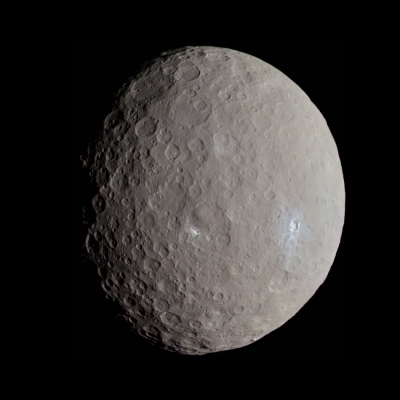Eris (minor-planet designation 136199 Eris) is the most massive and second-largest known dwarf planet in the Solar System. It is a trans-Neptunian object (TNO) in the scattered disk and has a high-eccentricity orbit. Eris was discovered in January 2005 by a Palomar Observatorybased team led by Mike Brown and verified later that year. In September 2006, it was named after the GrecoRoman goddess of strife and discord. Eris is the ninth-most massive known object orbiting the Sun and the sixteenth-most massive overall in the Solar System (counting moons). It is also the largest object that has not been visited by a spacecraft. Eris has been measured at 2,326 12 kilometers (1,445 7 mi) in diameter; its mass is 0.28% that of the Earth and 27% greater than that of Pluto, although Pluto is slightly larger by volume.Eris has one large known moon, Dysnomia. In February 2016, Eris's distance from the Sun was 96.3 AU (14.41 billion km; 8.95 billion mi), more than three times that of Neptune or Pluto. With the exception of long-period comets, Eris and Dysnomia were the most distant known natural objects in the Solar System until the discovery of 2018 VG18 in 2018.Because Eris appeared to be larger than Pluto, NASA initially described it as the Solar System's tenth planet. This, along with the prospect of other objects of similar size being discovered in the future, motivated the International Astronomical Union (IAU) to define the term planet for the first time. Under the IAU definition approved on August 24, 2006, Eris, Pluto and Ceres are "dwarf planets", reducing the number of known planets in the Solar System to eight, the same as before Pluto's discovery in 1930. Observations of a stellar occultation by Eris in 2010 showed that it was very slightly smaller than Pluto, which was measured by New Horizons as 2,377 4 kilometers (1,477 2 mi) in July 2015.
A dwarf planet is a small planetary-mass object that is in direct orbit of the Sun – something smaller than any of the eight classical planets, but still a world in its own right. The prototypical dwarf planet is Pluto. The interest of dwarf planets to planetary geologists is that, being possibly differentiated and geologically active bodies, they may display planetary geology, an expectation borne out by the Dawn mission to Ceres and the New Horizons mission to Pluto in 2015.
Counts of the number of dwarf planets among known bodies of the Solar System range from 5-and-counting (the IAU) to over 120 (Runyon et al). Apart from Sedna, the largest ten of these candidates have either been visited by spacecraft (Pluto and Ceres) or have at least one known moon (Pluto, Eris, Haumea, Makemake, Gonggong, Quaoar, Orcus, Salacia), which allows their masses and thus an estimate of their densities to be determined. Mass and density in turn can be fit into geophysical models in an attempt to determine the nature of these worlds.
The term dwarf planet was coined by planetary scientist Alan Stern as part of a three-way categorization of planetary-mass objects in the Solar System: classical planets, dwarf planets and satellite planets. Dwarf planets were thus conceived of as a category of planet. However, in 2006 the concept was adopted by the International Astronomical Union (IAU) as a category of sub-planetary objects, part of a three-way recategorization of bodies orbiting the Sun: planets, dwarf planets and small Solar System bodies. Thus Stern and other planetary geologists consider dwarf planets to be planets, but since 2006 the IAU and perhaps the majority of astronomers have excluded them from the roster of planets.

2005Oct, 21
Images of the dwarf planet Eris are taken and subsequently used in documenting its discovery by the team of Michael E. Brown, Chad Trujillo, and David L. Rabinowitz.
Choose Another Date
Events on 2005
- 24Apr
Pope Benedict XVI
Cardinal Joseph Ratzinger is inaugurated as the 265th Pope of the Roman Catholic Church taking the name Pope Benedict XVI. - 25Apr
European Union
Bulgaria and Romania sign accession treaties to join the European Union. - 17Aug
Israeli disengagement from Gaza
The first forced evacuation of settlers, as part of Israeli disengagement from Gaza, starts. - 24Oct
Effects of Hurricane Wilma in Florida
Hurricane Wilma makes landfall in Florida resulting in 35 direct 26 indirect fatalities and causing $20.6B USD in damage. - 30Oct
Bombing of Dresden in World War II
The rebuilt Dresden Frauenkirche (destroyed in the firebombing of Dresden during World War II) is reconsecrated after a thirteen-year rebuilding project.

 English
English  español
español  français
français  português
português  русский
русский  العربية
العربية  简体中文
简体中文 